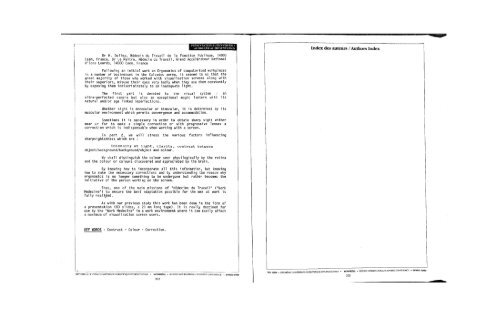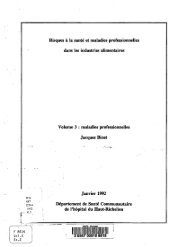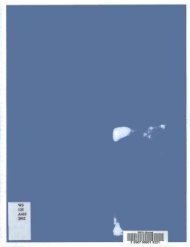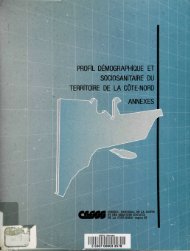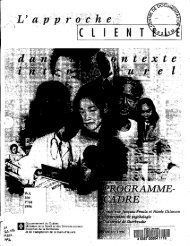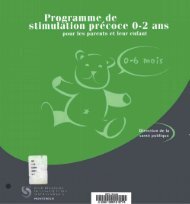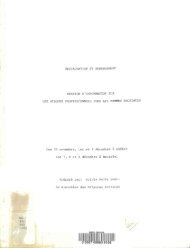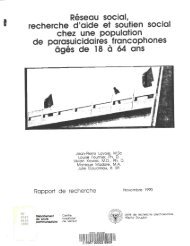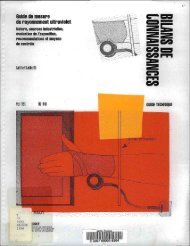i'ki:si:m a I ion vi dio vimji.i 1.1VI DIO VIM VI I'lU SIM VITON"IS THERE AN ERGONOMIST IN THE MENU ?" September 1988 Brussels - BelgiumVISION - TEV - SANTEiM{fiSi;N I A rU)\ Al!l)K) VISI IU 11;AI DIOA IS! AI. IMU SIM V HONA 30 minutes vi<strong>de</strong>ogram availab<strong>le</strong> in English,French and Dutch.Co-producers :. Institut pour l'Amélioration <strong>de</strong>s Conditions <strong>de</strong> Travail (I.A.C.T.), 60 rue <strong>de</strong>la Concor<strong>de</strong>, 1050 Bruxel<strong>le</strong>s. Service médical interentreprises M.S.R., 16 Quai aux Pierres <strong>de</strong> Tail<strong>le</strong>,1000 Bruxel<strong>le</strong>s. Service médical interentreprises Santé et Travail, 128 avenue Henri Jaspar,1060 Bruxel<strong>le</strong>s.Multidisciplinary team :. Dr. Jean DE MEYER, équipe ergonomique du Service médical interentreprises M.S.R.. Prof. José GAUSSIN, Unité <strong>de</strong> Psychologie du Travail et <strong>de</strong>s Organisations,Université Catholique <strong>de</strong> Louvain (U.C.L.). Dr. Robert LEONARD, Service d'ergonomie et <strong>de</strong> documentation du Service médicalinterentreprises Santé et Travail. Prof. René PATESS0N, Section d'informatique et Sciences humaines, Faculté <strong>de</strong>sSciences socia<strong>le</strong>s, politiques et économiques, Université Libre <strong>de</strong> Bruxel<strong>le</strong>s(U.L.B.). Elisabeth WENDELEN, industrial psychologist, I.A.C.T.Production supervision : Mrs. E. WENDELEN, I.A.C.T.This vi<strong>de</strong>ogram is meant for :. <strong>de</strong>cision takers. members of occupational health services, safety services. training officers. members of health and safety committees. tra<strong>de</strong> union representatives,who either have already been computerized or will be soon.Contents of the vi<strong>de</strong>ogram :- Work station :How to choose, combine and arrange the individual components (screen, keyboard,tab<strong>le</strong>, chair, etc...) and how the environment should be adapted after havingma<strong>de</strong> a study of the function and tasks.- Software ergonomics :Communicating <strong>with</strong> the machine has to be adjusted to the way the user thinks,speaks, memorizes, discerns, processes the information and solves the prob<strong>le</strong>ms.- Work organisation :How to make use of the opportunities opened up by informatics <strong>with</strong> a viewto improving <strong>work</strong>ing conditions, i.e. quality, diversity and importance ofthe tasks.- User health :How to avoid eye fatigue and posture-related complaints when <strong>work</strong>ing on ascreen for long periods on end.- Legal aspects :Rights and duties of employees, employers, occupational health and safetyofficers and tra<strong>de</strong> unionists whenever an informatics project is in the offing.Dr M. Dol<strong>le</strong>y, Mé<strong>de</strong>cin du Travail <strong>de</strong> la Fonction Publique, 14000Caen, France Dr. Le Maître, Mé<strong>de</strong>cin du Travail, Grand Accélérateur Nationald'Ions Lourds, 14000 Caen, FranceA la suite d'un premier <strong>travail</strong> sur l'Ergonomie <strong>de</strong>s postes <strong>de</strong><strong>travail</strong> informatises <strong>de</strong> différentes entreprises du département du Calvados,il nous apparut que la très gran<strong>de</strong> majorité <strong>de</strong>s personnes <strong>travail</strong>lant surécran <strong>de</strong> <strong>visualisation</strong> ainsi que <strong>le</strong>urs responsab<strong>le</strong>s hiérarchiques, s'ilsutilisaient effectivement <strong>le</strong>urs yeux <strong>à</strong> tout instant, ne <strong>le</strong>s connaissaittoutefois que très mal, <strong>le</strong>s exposant sans discernement <strong>à</strong> une lumière nonadéquate.La première partie est consacrée au système visuel : caméraultra-perfectionnée mais aussi admirab<strong>le</strong> lanterne magique avec sesimperfections naturel<strong>le</strong>s et/ou liées <strong>à</strong> l'âge.Que la vision soit monoculaire, ou binoculaire, el<strong>le</strong> estdéterminée par son environnment musculaire, qui permet convergence etaccommodation.L'acuité visuel<strong>le</strong> <strong>de</strong> près ou <strong>de</strong> loin nécessite parfois unecorrection simp<strong>le</strong> ou avec verres progressifs, correction qui estindispensab<strong>le</strong> lors du <strong>travail</strong> sur écran.Nous insisterons dans la 2e partie, sur <strong>le</strong>s différents facteursvenant influer sur l'acuité visuel<strong>le</strong> qui sont :- l'intensité lumineuse, la clarté, <strong>le</strong> contraste objet/fond/fondobjet, la cou<strong>le</strong>ur.Nous distinguerons la cou<strong>le</strong>ur vue physiologiquement par laet la ou <strong>le</strong>s cou<strong>le</strong>urs, découvertes et appréciées par <strong>le</strong> cerveajj.rétineEn sachant intégrer toutes ces données, en sachant fairès <strong>le</strong>scorrections qui s'imposent, en en connaissant <strong>le</strong> pourquoi, l'Ergonomien'est plus une chose subie, mais <strong>de</strong>vient <strong>à</strong> l'initiative du <strong>travail</strong><strong>le</strong>ur surécran.Ainsi, une <strong>de</strong>s missions principa<strong>le</strong>s du Mé<strong>de</strong>cin du Travail -assurer la meil<strong>le</strong>ure adéquation possib<strong>le</strong> <strong>de</strong> l'homme au <strong>travail</strong>, se trouvep<strong>le</strong>inement réalisée.Comme notre précé<strong>de</strong>nte étu<strong>de</strong>, ce <strong>travail</strong> est réalisé sous la formed'un diaposon (80 Diapos, ban<strong>de</strong> son • ... ëe 20 mn). Il est en effet <strong>de</strong>stine aêtre utilisé par <strong>le</strong> Mé<strong>de</strong>cin du Travail, en milieu <strong>de</strong> <strong>travail</strong> touchantfaci<strong>le</strong>ment un maximum d'utilisateurs d'écrans <strong>de</strong> <strong>visualisation</strong>.MOTS CLES : Contraste - Cou<strong>le</strong>ur - Correction.Keys-words: TEV - Ergonomics - Vi<strong>de</strong>ogramTEV 1989 — DEUXIÈME CONFÉRENCE SCIENTIFIQUE INTERNATIONALE • MONTRÉAL • SECOND INTERNATIONAL SCIENTIFIC CONFERENCE — WWDU 1989200TEV 1989 - - DEUXIÈME CONFÉRENCE SCIENTIFIQUE INTERNATIONAL!MONTRÉAL • SECOND INTERNATIONAL SCIENTIFIC CONFERENCE201- WWDU 1989
PRÉSENTATION AlUHO-VISI iEI.l i;AUDIO-VISIIAI. PRESENTATIONIn<strong>de</strong>x <strong>de</strong>s auteurs / Authors In<strong>de</strong>xDr M. Dol<strong>le</strong>y, Mé<strong>de</strong>cin du Travail <strong>de</strong> la Fonction Publique, 14000Caen, France, Dr Le Maître, Mé<strong>de</strong>cin du Travail, Grand Accélérateur Nationald'Ions Lourds, 14000 Caen, FranceFollowing an initial <strong>work</strong> on Ergonomics of computerised <strong>work</strong>placesin a number of businesses in the Calvados aerea, it seemed to us that thegreat majority of those who <strong>work</strong>ed <strong>with</strong> <strong>visualisation</strong> screens along <strong>with</strong>their superiors, misuse their eyes very badly when they use them constantlyby exposing them indiscriminately to an ina<strong>de</strong>quate light.The first part is <strong>de</strong>voted to the visual system : anultra-perfected camera but also an exceptional magic lantern <strong>with</strong> itsnatural and/or age linked imperfections.Whether sight is monocular or bimocular, it is <strong>de</strong>termined by itsmuscular environment which permits convergence and accommodation.Sometimes it is necessary in or<strong>de</strong>r to obtain sharp sight eithernear or far to make a simp<strong>le</strong> correction or <strong>with</strong> progressive <strong>le</strong>nses acorrection which is indispensab<strong>le</strong> when <strong>work</strong>ing <strong>with</strong> a screen.In part 2, we will stress the various factors influencingsharpsightedness which are :intensity at light, clarity, contrast betweenobject/background/background/object and colour.We shall distinguish the colour seen physilogically by the retinaand the colour or colours discovered and approciated by the brain.By knowing how to incorporate all this information, but knowinghow to make the necessary corrections and by un<strong>de</strong>rstanding ttie reason whyergonomics is no longer something to be un<strong>de</strong>rgone but rather -becomes theinitiative of the person <strong>work</strong>ing on the screen.Thus, one of the main missions of "Mé<strong>de</strong>cine du Travail" ("WorkMe<strong>de</strong>cine") to ensure the best" adaptation possib<strong>le</strong> for the man at <strong>work</strong> isfully realised.As <strong>with</strong> our previous study this <strong>work</strong> has been done in the form ofa presentation (80 sli<strong>de</strong>s, a 20 mn long tape). It is really <strong>de</strong>stined foruse try the "Work Me<strong>de</strong>cine" in a <strong>work</strong> environment where it can easily affecta maximum of <strong>visualisation</strong> screen users.KEY WORDS : Contrast - Colour -Correction.TEV 2031989 — DEUXIÈME CONFÉRENCE SCIENTIFIQUE INTERNATIONALE • MONTRÉAL • SECOND INTERNATIONAL SCIENTIFIC CONFERENCE — WDU 1989TEV 1989 — DEUXIÈME CONFÉRENCE SCIENTIFIQUE INTERNATIONALE • MONTREAL • SECOND193IN'ITiRNATIONAI. SCIENTIFIC CONFERENCE — WWDU 1989


